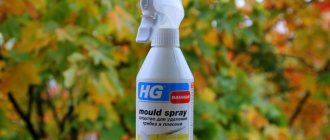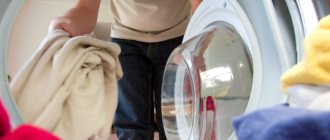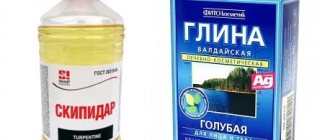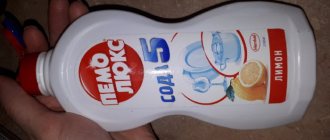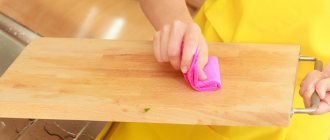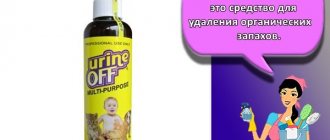0
15717
Everyone needs to know how to get rid of the smell of dampness and mold on clothes. This problem is especially common in private homes, in rooms with high humidity, and in closets with things. In order to prevent the appearance of odors, it is necessary to follow the rules for storing textiles.
Where does the smell come from?
The smell of dampness and mold forms on things that have not been properly cared for. Three possible causes of the problem:
- lack of drying outerwear after a walk in damp or snowy weather;
- storing undried items after washing;
- presence of debris or food debris in pockets;
- high indoor humidity;
- lack of ventilation.
The appearance of a damp and moldy smell from completely dried, clean items is considered rare. This applies to clothes, shoes, bed linen, towels, blankets and other textiles.
Open the door
After cleaning, open the door and ventilate the drum. This procedure should be carried out after each wash to allow the internal parts of the unit to dry. Mold likes to grow in damp and dark places. Ventilation and light will prevent its appearance.
Lost weight: what Sofia Tarasova sacrificed for the sake of “VIA Gra” (new photos)
It’s good to wash often: myths about shampoo and hair care that only harm
“We are still friends”: Derevianko commented on the breakup with his wife
The use of folk remedies
Using products that are always available at home, you can easily remove the smell of mold and dampness from clothes. When using traditional methods, you should first test their effect on a small area of linen, and then carry out a complete cleaning.
Types of products for cleaning mold and dampness of certain types of fabrics:
| Type of fabric | Facilities |
| White | 1. Ascorbic acid. 2. Hydrogen peroxide. 3. Ammonia. 4. Vinegar. |
| Colored, dark | 1. Alcohol. 2. Soda. 3. Potato starch. 4. Ground coffee. |
| Wool, fur coats | 1. Dry cleaning products. 2. Vinegar, ammonia. 3. Vodka. 4. Sand. |
To prevent mold and the smell of dampness, you can place bags of salt and rice in the closet - they will absorb excess moisture and eliminate strong aromas.
Salt
Absorbs odors well, removes dirt, and helps remove damp odors from clothes. To do this, you need to dilute 2 tablespoons of salt and 1 tablespoon of ammonia in a liter of water. Boil the mixture for half an hour. The prepared solution is applied to the dirt for 30-60 minutes. After this soaking, the item is washed as usual.
Soda
Baking soda is good at eliminating the smell of mold and dampness.
It can be added to regular washing powder in the amount of 1 tablespoon per machine wash. When cleaning delicate or brightly colored fabrics, the water should be no more than 40 degrees. Higher temperatures are suitable for bleaching items. When washing by hand, 1 tablespoon of the substance per 10 liters of water is enough. Baking soda is used to remove small stains. To do this, the soda slurry obtained by mixing with water is applied to the stain, left for 15-30 minutes, after which the clothes are washed as usual.
Lemon acid
It will help to whiten, remove stains and remove the smell of mold from clothes at home. To do this, citric acid must be mixed with vinegar and applied to the areas required for cleaning. To give the fabric a fresher look and whiten, 1 tablespoon of citric acid is added to the drum of the washing machine.
Ascorbic acid
Used together with alcohol - a teaspoon of acid must be dissolved in 50 ml. The resulting solution is applied with a cloth or cotton pad to dirt or mold. Clothes should be allowed to sit for 30-60 minutes and then washed.
Potato starch
In order to remove the smell of dampness from clothes, starch is suitable only in dry form. To do this, you need to scatter it over your laundry, leave it for several hours, then shake it out thoroughly. Potato starch can be stored in fabric bags in cabinets to absorb moisture and prevent mold.
Ground coffee
Apply the coffee grounds to dirty stains and leave for several hours until completely dry. Brush off any remaining residue, then wash the clothes. This method removes not only dirt, but also strong unpleasant odors.
Ammonia and ammonia
Helps eliminate mold and damp smell from clothes. For this, a solution of ammonia is used, prepared at the rate of 10 ml of the substance per 1 liter of water. Things should be soaked in the product for 5-15 minutes, then washed as usual.
Vodka and alcohol
Refreshes clothes and gets rid of stench. Vodka is added to water in a volume of 2 tablespoons per 70-100 ml of water. The mixture is poured into a spray bottle, the item is sprayed with it, and then allowed to sit for 20-30 minutes. After time, the items are washed with regular powder.
Hydrogen peroxide
Used against dampness only for light and white fabrics, as it has strong bleaching properties. Dilute peroxide with a concentration of 3% in water in a ratio of 1:2, apply to a sponge or cloth, treat dirty places and areas with mold. Let the clothes sit for 10-15 minutes, then wash.
Turpentine
Copes well with dampness, fungi and mold. Using a cotton pad or sponge soaked in turpentine, treat all necessary areas of the fabric, then wash. In order to get rid of the smell of the substance, it is recommended to use scented powder or fabric softener. Another option is possible - at least 2-3 rinses of treated clothing.
Clay
Helps remove damp odors from clothes, refreshing them. White clay is ideal for this purpose. Sprinkle its powder on areas that smell of dampness and mold, place heat-resistant paper or foil on top and iron it with an iron. Treated clothing is washed as usual.
Clay is also suitable for preventing mold and dampness. To do this, things need to be periodically processed in the above manner or rag bags with clay should be placed in cabinets.
Borax
Borax is sold at the pharmacy and costs about 50 rubles. To remove the smell of dampness and mold from clothes, 2 tablespoons of the substance along with washing powder are diluted in 10 liters of water for soaking things. After two hours, do a normal wash.
Onion
Regular onions have antibacterial properties and can eliminate unpleasant odors, traces of dampness and mold. To do this you will need onion juice or vegetable pulp. The resulting liquid should be applied to dirty spots and left until completely dry. After the procedure, clothes are washed in a machine at a temperature of 40 degrees.
Sour milk
Kefir, fermented baked milk and other fermented milk products are good at removing the smell of mold and dampness. To clean, you need to dilute them with a small amount of water and soak the clothes. This method is best suited for white and light-colored fabrics, since sour milk has a bleaching effect. After soaking, wash items as usual.
Boiling
If you smell old clothes or mold, don't rush to throw away your wardrobe items, try boiling them. True, this method is only suitable for durable fabrics; clothes made of delicate materials will not tolerate such a procedure. To boil things, you will need a large pot to boil water in. It will need to be poured into a basin, all the wardrobe items or textiles that need to be processed should be placed in it and left for 5 minutes. After this, things must be washed and dried thoroughly.
Household chemicals
The easiest way to get rid of the smell of dampness and mold on clothes at home is by using household chemicals. The following tools are suitable for this:
- Bleach. Ideal for adding freshness to white items. Eliminates odors of mold and dampness from clothes, prevents the formation of fungus.
- Stain remover. Suitable for removing heavy stains on any fabric.
- Antifungal agents Valo, Prosept, Element. Sold in specialized departments or online stores. Designed to combat mold and other types of organic tissue damage.
- Conditioner or rinse aid. Gives laundry a pleasant aroma and helps remove the smell of dampness from clothes when washing.
Along with any type of detergent, washing powder is used to eliminate mold and traces of dampness. It is selected depending on the type of fabric, but when washing with additional substances it is added in smaller volumes.
Dry items immediately
With any washing method, do not allow the laundry to remain wet for a long time. Immediately transfer items to the dryer or hang them flat on a line.
When drying, do not pack things too tightly. There should be enough space between them to allow air to circulate. This will help ventilate clothes and eliminate unpleasant odors.
If you dry your clothes naturally, it is better to do it outdoors rather than indoors. Sunlight will destroy any remaining bacteria and mold spores.
Washing cotton, calico and linen from odor
Bed linen and other home textiles are usually made from such materials. It is more susceptible to damp and musty odors due to the fact that it is not used as regularly as everyday clothing.
Additional folk remedies for washing calico, linen and cotton:
- salt - added to the powder in a ratio of 1:3 or applied to the dirt in the form of a slurry;
- onions - its juice is added to the basin when soaking;
- fermented milk products - diluted with water 1:1 for soaking fabrics.
To prevent the formation of dampness and mold in closets, used bed linen should be washed with special household chemicals or folk remedies that eliminate odor.
Hydrogen peroxide
How to remove musty smell from clothes? Experts recommend using a product such as hydrogen peroxide. It will remove any odors of organic origin: the smell of dampness, sweat and fungus. Peroxide also helps to deal with old stains left on clothes from juice, blood and grass. To prepare a detergent for washing clothes, you will need a liter of water and 100 milliliters of hydrogen peroxide. If you need to clean cotton products, the peroxide does not need to be diluted. It should be noted that you can soak the fabric in this composition for no more than 15 minutes.
Dry cleaning
Sometimes dry cleaning is all you need to get rid of the musty smell from your clothes. This will help if there is no visible contamination. Possible types:
| Dry Cleaner | Method of application |
| Soda and potato starch | Sprinkle on clothes, rub in, let sit for 10-30 minutes and shake off. |
| Stain remover pencil | Use according to instructions on individual areas of the item. |
| Clay | Apply as soda or additionally iron after rubbing into the fabric. |
| Dry cleaning products | They not only get rid of the smell of dampness and mold, but also remove dirt. Use according to instructions. Can be used in a washing machine on drying mode. |
Dry cleaning products, with the exception of dry cleaning, are suitable for adding freshness to laundry or when a full wash is not possible. They can also be used to prevent the formation of mold and dampness in clothes that have not been used for a long time and are stored in a closet.
Why do clothes stink after washing?
There are many reasons, but most often it is a careless housewife.
Why clothes stink after washing:
- Dirty washing machine. An unpleasant musty smell is associated with mold accumulation in the washing machine. Usually it accumulates both in the drum itself and on the seal. Therefore, be sure to wipe the rubber seal after each wash, removing moisture with a towel or regular napkins. Do not close the door under any circumstances; leave it ajar. This will promote drying and evaporation of moisture, preventing the growth of mold.
- Using low-quality detergents. Remember that powdered detergents are best used at high temperatures of 60 degrees. In a short washing cycle, at 40 degrees, such powders may not have time to dissolve, so solid grains settle on the hoses, seal, and inside the drum. This is an excellent breeding ground for pathogenic microorganisms that cause an unpleasant odor.
Wash
Cleaning fur coats
Folk remedies are also suitable for removing the smell of dampness and mold from a fur coat. Cleaning is carried out only using the dry method, while the product should hang on a hanger. Possible methods:
- Ammonia. Dilute 2 teaspoons of the product in 1 liter of water. Moisten the brush in the resulting solution and treat the product with it, avoiding getting it too wet.
- Laundry soap. Grate the block and mix with hot water until foam is obtained. Apply to the front of the fur coat, then wipe with ammonia solution.
- Vodka and alcohol. Dilute with water in a 1:1 ratio and spray onto the fur from a spray bottle. For ventilation, hang it outside for 1-2 days.
It is recommended to take fur coats and other fur products to specialized dry cleaners. This will prevent possible damage if washing is carried out incorrectly.
Don't overload the drum
Don't try to get the job done faster by overloading the machine drum. Correct loading is very important for the quality of the wash. Fill the tank with laundry no more than three-quarters full. In this case, the clothes should not be tightly packed.
"Dad is offended." Agata Muceniece about her relationship with Priluchny after the divorce
Smooth and fresh skin: dermaplaning, or why a woman needs to shave her face
Rare shot: Viktoria Isakova showed her grown-up daughter from Yuri Moroz (new photo)
Prevention of odors
To keep your clothes from smelling damp and moldy, you need to take proper care of them. It is recommended to do the following:
- put only completely dried items in the closet;
- ventilate the rooms 1-3 times a day for 15 minutes;
- wash clothes with baking soda every two weeks.
It is necessary to monitor the condition of the furniture and the things lying in it. Storage rules that help get rid of the smell of dampness and mold in the closet with clothes;
- regularly sort through shelves with things for ventilation;
- wipe the inside of the cabinet using household chemicals or other disinfectants;
- store towels, bed linen, clean and regularly used clothing separately;
- ironing clean items before putting them in the closet;
- washing seasonal clothes before long-term storage.
Sometimes the shelves in the closet begin to rot from old age. They should be replaced with new ones, otherwise the fabrics will absorb this smell or may also be affected by rotting processes.
To prevent things from smelling damp and moldy, they need to be properly cared for. If your clothes have already begun to smell unpleasant, then to eliminate this problem you can resort to folk remedies or household chemicals. Storing items for a long time in a damp place can lead to their damage.
Pre-soak
If your items still have a sour or musty smell after a previous unsuccessful wash, use pre-soaking. This will help eliminate the stench.
Fill the bathtub or sink with water. Dissolve half a glass of baking soda in the liquid. Soak the items overnight in the prepared mixture, and in the morning wash them as usual, trying to avoid mistakes.
Some features
Let's look at popular types of towels and their “relationship” with unpleasant odors.
Linen, cotton fabrics
As you know, any natural base (naturally, one that does not produce antiseptic substances) is an excellent base for the proliferation of microorganisms. Therefore, let’s destroy the myth that linen towels do not smell.
Both cotton and linen need proper care, regular washing and proper drying, so that products made from these materials do not begin to emit an unpleasant odor.
Bamboo towels
Manufacturers of this textile report that bamboo fiber produces a fairly strong antiseptic, which prevents the proliferation of microorganisms (in particular, mold), and, as a result, the formation of an unpleasant odor. Because of this, bamboo towels, the price of which stands out compared to the cost of their “brothers,” are considered the most hygienic.
An unpleasant odor can also haunt bamboo.
But is it? Many housewives note that over time, even such products begin to smell unpleasantly. What's the matter? We can imagine two options:
- There are very few pure bamboo products on the market. Basically it is a combination with cotton (5/5, 6/4). Perhaps a non-100% concentration weakens the antiseptic effect.
- As we know, medicinal herbs do not retain their healing properties forever. The maximum period is 5 years. The same can be observed with respect to the plant component - bamboo. It is possible that over time the concentration of released antiseptic substances decreases.



